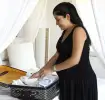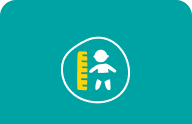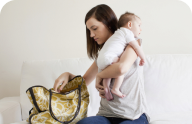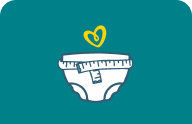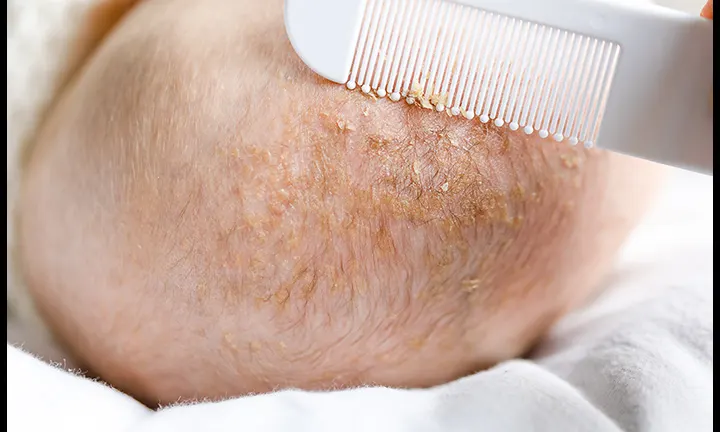Explore
Diapering
Tools you might be interested in
Cradle Cap in Babies
Are you noticing scales or flakes of skin on your baby’s scalp (or elsewhere on their body)? This may be infantile seborrheic dermatitis, better known as cradle cap. It’s basically dandruff for babies. Although it can look a little unpleasant, it isn’t harmful. There is no quick cure for your baby’s cradle cap, but there are some things you can try to help soothe their skin until it clears, which is usually after a few months or so.
What Is Cradle Cap?
Cradle cap is what seborrheic dermatitis is called when it appears on your baby’s scalp.
The cradle cap skin condition can show up elsewhere, too, such as on your baby’s face, ears, eyelids, eyebrows, and nose, or on the body, on the neck, armpit, belly button, legs, and groin.
When the symptoms of cradle cap appear anywhere other than the scalp, your provider will refer to it as seborrheic dermatitis.
So, do all babies get cradle cap? Cradle cap is very common in babies, with an estimated 70% of 3-month-old babies having the skin condition.
The good news is that cradle cap isn’t contagious, and it generally isn’t painful or itchy for your little one. Plus, it won’t leave any scars.
When Does Cradle Cap Start?
Your baby is most likely to develop cradle cap between 2 weeks old and 12 months old. As we mentioned above, cradle cap is very common in babies and is unlikely to cause any discomfort.
When Does Cradle Cap Go Away?
How long does cradle cap last? Cradle cap is likely to clear up on its own within weeks or months or by the time your little one is about 1 year old. Although cradle cap generally doesn’t require any treatment to clear up, we have listed some options in our Cradle Cap Treatment section that you can do at home to help manage your little one’s cradle cap.
In some cases, cradle cap can return during your child’s first year, even after treatment. This skin condition can even return as dandruff when your child hits puberty.
Does Cradle Cap Come Back?
In some cases, cradle cap can return during your child’s first year, even after treatment. This skin condition can even return as dandruff when your child hits puberty.
What Causes Cradle Cap?
It’s not known exactly why babies get cradle cap, but experts say it’s not caused by poor hygiene or an allergy to something you’re using.
One factor may be that some of your pregnancy hormones have passed on to your baby before birth, causing the production of too much oil (sebum) in the oil glands and hair follicles, trapping dead skin cells. This is likely why the skin condition usually occurs wherever there are the most oil-producing sebaceous glands.
Another contributor may be Malassezia, a yeast (fungus) that grows in the sebum along with bacteria.
Cradle Cap Symptoms
The symptoms of cradle cap may include the following:
Patches, scales, or thick crusts on your baby’s scalp
Skin flakes
A greasy or waxy feeling when you touch the patches or scales
Some mild inflammation around the patches or scales
The condition can also affect areas other than the scalp, such as the ears, eyelids, nose, and groin
The condition doesn’t cause any discomfort, itching, or pain.
What Does Cradle Cap Look Like?
Cradle cap typically looks like skin that has red, moist patches. On darker skin tones, the rash may appear lighter or darker than the baby’s usual skin color. It commonly appears in skin folds near the neck or behind the ears. It can sometimes look yellowish with greasy patches, or it might appear scaly or flaky.
Cradle cap does often get confused with other conditions that look like seborrheic dermatitis, including eczema, but unlike eczema, cradle cap is mild and usually isn’t itchy or uncomfortable.
If seborrheic dermatitis appears on your little one’s groin, it’s easy to confuse with diaper rash but these conditions are not the same.
Cradle Cap Vs Dry Skin
Although dry skin and cradle cap can easily be confused on an infant, cradle cap is often characterized by patches or scales on the scalp that feel waxy or greasy rather than dry. If you’re unsure whether your baby has cradle cap or some other type of rash, you can consult their healthcare provider.
Cradle Cap Treatment
Cradle cap doesn’t usually require any specialized medical treatment. Healthcare providers usually recommend treating your baby’s cradle cap yourself at home using the tips we listed below.
In some cases, your healthcare provider might recommend using a stronger medicated shampoo, hydrocortisone cream, or an anti-fungal cream if the at-home tips aren’t working. You should always check with your healthcare provider before trying any medicated treatments for cradle cap, as they can be irritating to your baby’s skin.
Cradle Cap Self-Care
The scales that result from cradle cap aren’t easy to remove, but here’s how to help get rid of cradle cap with some simple home remedies that are recommended by healthcare providers:
Wash your baby’s hair frequently, even daily, with a mild baby shampoo while you bathe your baby.
If normal baby shampoo doesn’t seem to work, ask your healthcare provider to recommend a medicated shampoo specifically designed for cradle cap.
Gently comb any hair and brush over the scales with a soft bristle brush to loosen the flakes of skin. Don’t scratch or rub the skin affected by cradle cap. Wash loose flakes away with water.
If the scales don’t loosen, consider massaging petroleum jelly onto your baby’s scalp to help lift any stubborn, dry skin. Don’t use baby oil or mineral oil for cradle cap, as it can cause more scaly buildup. Wash your baby’s hair afterward with shampoo.
Although you might have heard of a home remedy or two for cradle cap, such as coconut oil, it’s best to ask your provider before trying any of these.
How to Prevent Cradle Cap
There’s no guaranteed way to prevent cradle cap, but following the at-home tips mentioned above, like regularly washing your baby's hair with a gentle baby shampoo, and seeking advice from your healthcare provider, can help minimize the flakes and stop them from recurring.
When to See Your Healthcare Provider
Consult your provider if shampooing doesn’t help, if the cradle cap seems severe, or if it’s also present on your baby’s face or body. Your healthcare provider may prescribe a medicated shampoo, cream, or an anti-fungal treatment if your little one’s cradle cap doesn’t go away on its own.
The Bottom Line
Cradle cap can look a little concerning at first, but it will clear up in time. Following the tips above, as well as some general baby skin care tips, can help ensure your baby’s skin is protected and healthy.
To earn points for all your purchases, including the baby wipes you’ll be using to keep your little one’s skin clean, download the Pampers Rewards app today.
How We Wrote This Article The information in this article is based on the expert advice found in trusted medical and government sources, such as the American Academy of Pediatrics and the American College of Obstetricians and Gynecologists. You can find a full list of sources used for this article below. The content on this page should not replace professional medical advice. Always consult medical professionals for full diagnosis and treatment.
Join a World of Support
through Pregnancy and Parenthood.
TRACK WITH TOOLS
LEARN WITH EXPERTS
GET REWARDED
















